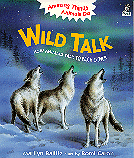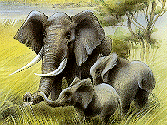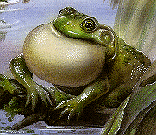


|
Wild Talk: How Animals Talk to Each Other.
Marilyn Baillie. Illustrated by Romi Caron.
Grades 3 - 5 / Ages 8 - 12. ***/4
|

excerpt:
Is that a bright red balloon in the branches? No, it's a male great frigate bird. He has a colourful way to signal that he is looking for a mate. His fire-red throat pouch puffs out, shining in the Galapagos sun. He shows off, flapping his wings and clacking his bill. Finally, a female arrives to be his partner. They build a nest of twigs and hatch one white egg into a chick.
 Children are fascinated with the means that animals use to communicate with each other. In her book Wild Talk: How Animals Talk to Each Other, a part of the Amazing Things Animals Do series, Marilyn Baillie has carefully selected a variety of sensory methods of animal communication. The table of contents gives clues to the method of communication and specifically states the animal being highlighted. From the "Smelly Signals of the Red-tailed Lemur" to the "Night Lights of the Firefly" and from the "Warning Whinny of the Zebra" to the "High Up Howling of the Red Howler Monkey," the reader will be awed by the wonders of nature.
Children are fascinated with the means that animals use to communicate with each other. In her book Wild Talk: How Animals Talk to Each Other, a part of the Amazing Things Animals Do series, Marilyn Baillie has carefully selected a variety of sensory methods of animal communication. The table of contents gives clues to the method of communication and specifically states the animal being highlighted. From the "Smelly Signals of the Red-tailed Lemur" to the "Night Lights of the Firefly" and from the "Warning Whinny of the Zebra" to the "High Up Howling of the Red Howler Monkey," the reader will be awed by the wonders of nature.
The book is laid out in two-page spreads for each of the twelve animals being highlighted. The print only takes up 25% of the entire area, leaving one and a half pages of illustrations for each creature. At the end of the book, one finds a "Who's Who" two-page synopsis of the animals, drawing attention to their global location and provides many interesting facts about them. The last page of the book presents a quiz with twelve questions. Personally, as a teacher-librarian actively involved in resource-based learning, I would have found a simple index more useful than the quiz. When purchasing resources for our Information Centre, I might have overlooked this book because of this factor which would have been a sad loss to our collection!

Romi Caron has done an exemplary job with the illustrations for this book. Although the theme of the book is limited to animals communicating with each other, the illustrations tempt you to find out more, in general, about these creatures. It is the realistic, enticing pictures, not the text, that would make this book an effective teaching tool for younger children. Each animal has a tiny photograph inset on the "Who's Who" page and a matching one on the individual two-page spread, but it is the painted illustrations of the creatures in their settings that are most visually satisfying.
An example from the "Who's Who" for the African Elephant clearly shows the reading level of the text.
"You can find African elephants in the forest and open Savannah areas of Africa. The low rumbling sound that they send over long distances comes from the area where their trunks meet their foreheads. It is called infrasound. Infrasound is also in wind, thunder and ocean storms, but we can't hear it." ...from Who's Who for the African ElephantBecause of the reading level of the text and the lack of an index for precise location of reference material, I would recommend this book for Grades 3-5 and for ages 8-12.
Recommended
Brenda Partridge is a teacher-librarian at Percy Centennial Public School in Warkworth, Ontario.

If you would like to order Wild Talk: How Animals Talk to Each Other. please fill out the form below:To comment on this title or this review, send mail to cmeditor@mts.net.
Copyright © 1996 the Manitoba Library Association. Reproduction for personal use is permitted only if this copyright notice is maintained. Any other reproduction is prohibited without permission.
Published by
The Manitoba Library Association
ISSN 1201-9364
AUTHORS |
TITLES |
MEDIA REVIEWS |
BOOKSHELF
BACK ISSUES |
SEARCH |
ORDER |
HOME